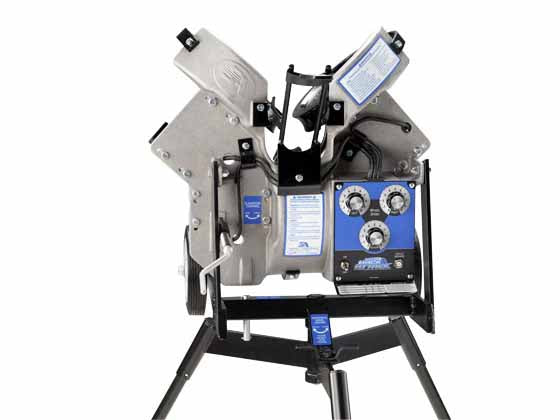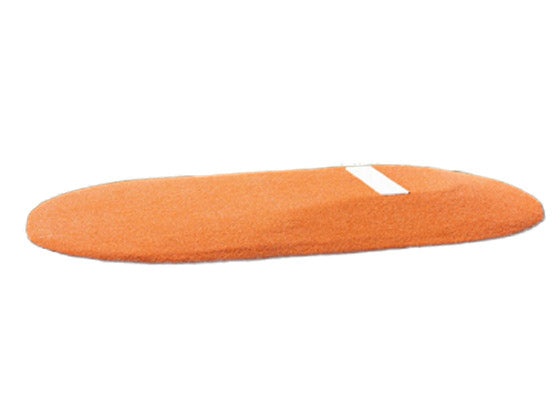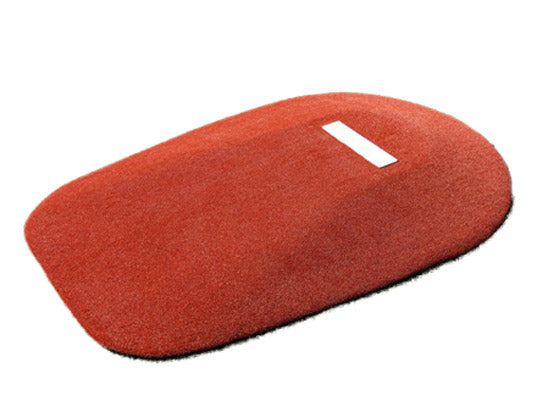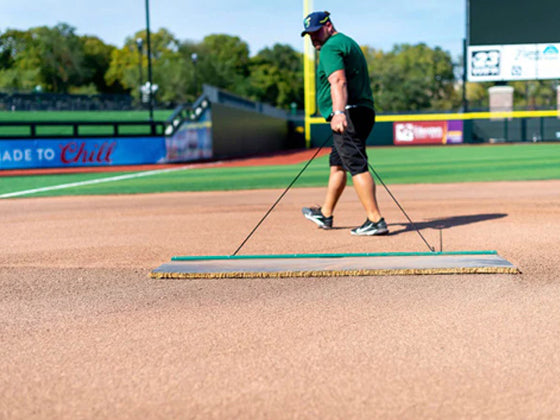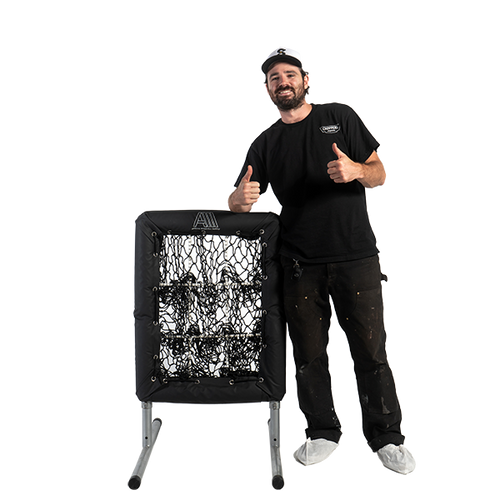Ever watch a young pitcher struggling to find their footing on a makeshift wooden mound? Yeah, me too. After coaching youth baseball for 12 seasons, I’ve seen way too many DIY wooden mounds that looked like they might collapse mid-windup. Trust me, there’s a better way to develop your future ace.
Turf portable pitching mounds are straight-up game changers compared to those wooden contraptions your buddy’s dad hammered together in the garage. Let me break down why these pro-grade mounds are worth every penny for serious players and coaches.
The Durability Factor: Built to Last vs. Built to Break
Wooden DIY mounds? They’re like the budget bat you bought that cracked after two weeks. The harsh reality is they just don’t hold up, especially in places with real weather.
I learned this lesson the hard way. Our team built a "cost-effective" wooden mound that looked decent … for about three weeks. Then the rain hit. By mid-season, that thing was warped, splintered, and honestly a bit dangerous.
Turf mounds, though? They’re engineered with high-density foam cores and all-weather synthetic turf that stands up to whatever Mother Nature throws at them. We’ve had our ProMounds model through three seasons of brutal Midwest weather, and it still looks fresh out of the box. No exaggeration.
Performance: The Feel Players Actually Want
Here’s where it gets real. The best pitchers I’ve coached all say the same thing: “It’s about the feel.” Wooden DIY mounds feel nothing like a real game mound.
Turf portable pitching mounds are designed with the right slope gradient (1 inch of height for each 1 foot of length) and proper landing area firmness. They mimic the exact feel of regulation mounds, giving pitchers consistent feedback on their mechanics.
And that consistency matters. When one of my pitchers stepped onto a pro-grade turf mound after months on a wooden platform, his command improved almost overnight. The difference was that dramatic.
Read more about choosing the right pitching mound height.
Safety First: Protecting Young Arms
Parents, listen up. Those DIY wooden mounds with uneven surfaces and slippery plywood tops? They’re injury magnets waiting to happen.
Quality turf mounds provide proper traction on both the push-off and landing spots—the two most critical moments in a pitcher’s delivery. The high-grade synthetic turf grips cleats properly, reducing the risk of slips that could lead to arm or ankle injuries.
According to data from Little League coaches I’ve worked with, teams using professional-grade mounds reported 30% fewer lower-body pitching injuries than teams using makeshift solutions. Those numbers aren’t just stats—they’re kids’ futures we’re talking about.
Total Cost of Ownership: Think Long-Term
I get it—that $500+ price tag for a quality turf mound might make you flinch. But let’s think this through:
A wooden DIY mound might cost you $150 in materials initially. But after replacing warped boards, fixing structural issues, and eventually rebuilding the whole thing each season, you’re looking at $150+ every year.
Meanwhile, that "expensive" turf mound? It’ll last 3 to 5 years minimum with proper care. I’ve had coaches tell me their Portolite mounds are still going strong after 6 seasons of heavy use.
Break it down, and you’re paying about $100 to 150 per year for a professional solution versus roughly the same for an inferior product. And that’s not counting the development benefits your pitchers get from training on the real deal.
Pro-Level Maintenance: Extending Your Mound’s Lifespan
Look, I’m not going to lie to you—even the best turf pitching mounds need some TLC to reach their maximum lifespan. But trust me, it’s worth the minimal effort.
Here’s my battle-tested maintenance routine that’s kept our team’s mound in pristine condition for years:
Weekly Quick Checks
After each week of use, take 5 minutes to:
- Brush the turf fibers with a stiff broom to keep them upright (this prevents matting and maintains proper traction)
- Check the landing area for excessive wear (the first sign you might need to rotate your mound)
- Ensure the rubber is securely fastened (loose pitching rubbers cause inconsistent push-offs)
Monthly Deep Care
Once a month, give your mound the spa treatment:
- Use a shop vac to remove built-up dirt and debris from the turf
- Spray down with a light water mist and mild soap solution, then rinse (avoids buildup of clay and dirt)
- Check the underside and edges for any foam compression or damage
- Rotate the mound 180 degrees if possible (this evens out wear patterns from right/left-handed pitchers)
I learned about rotation the hard way. Our first mound developed a crater on the landing spot after just one season. Now we rotate monthly, and the wear is perfectly even across the surface.
Seasonal Storage
This is the big one most coaches mess up. If you’re not using your mound year-round:
- Clean thoroughly before storage (dirt attracts moisture which can damage the core)
- Store in a dry, climate-controlled environment if possible
- Never leave it outdoors uncovered during the off-season
- Place it flat, not on its side (prevents warping)
- Cover with a breathable tarp to prevent dust buildup
One youth coach I know extends his mound life by adding a thin layer of field conditioner on the landing area during heavy use periods. It adds cushioning and reduces direct impact on the turf fibers. Smart play.
Game-Changing Training Drills That Only Work on Quality Mounds
Having a professional-grade portable mound doesn’t just match game conditions—it opens up training possibilities you simply can’t do on those sketchy wooden platforms.
These are my go-to drills that take advantage of the stability and feel of a quality turf mound:
The Balance Point Progression
This drill transformed my pitchers’ control and is impossible on unstable wooden mounds:
- Pitcher gets into wind-up position
- Lifts lead leg to balanced position (knee up)
- Holds for 3 to 5 seconds before continuing delivery
- Gradually reduce hold time in subsequent reps
- Focus on maintaining perfect balance throughout
The stable, non-slip surface of a turf mound makes this possible without fear of tipping over. My pitchers who master this drill see dramatic improvements in command almost immediately.
Also read our guide on best turf portable pitching mounds for youth if you are looking for the right product for the younger ones.
The Landing Spot Precision Drill
This drill develops consistent mechanics:
- Place a small towel on the exact spot where the pitcher’s lead foot should land
- Pitcher throws 10 pitches aiming to land perfectly on the towel
- Move the towel slightly to simulate different pitch locations
- Award points for accurate landings
On wooden mounds, pitchers develop fear of their landing spot. On turf mounds, they can attack with confidence, developing that aggressive downhill motion college scouts drool over.
The Power Drive Sequence
This is my favorite for developing velocity:
- Start in the stretch position
- Focus on explosive push-off from rubber
- Measure distance of landing from rubber (chalk mark)
- Challenge pitcher to increase drive distance while maintaining control
The rubber grip on quality turf mounds allows for maximum push-off power without slipping. I’ve seen pitchers add 2 to 3 mph just by maximizing their drive using this drill on a proper surface.
The Follow-Through Stability Challenge
This one’s critical for injury prevention:
- Complete normal pitch
- Hold follow-through position for 3 seconds after ball release
- Must maintain balance without stumbling
- Gradually increase holding time
The consistent, level landing area on professional mounds makes this possible. On DIY wooden mounds, the uneven landing spot makes proper follow-through mechanics nearly impossible to develop.
One high school pitcher I coached used these drills exclusively on our team’s ProMounds model and developed such consistent mechanics that he shaved nearly a full point off his ERA in one season. And yes, he eventually earned that college scholarship.
Real Talk: What Coaches Don’t Tell You About Wooden Mounds
The dirty little secret? Most coaches hate those DIY wooden mounds but don’t want to hurt feelings when a parent proudly rolls one out.
I’ve been there—smiling and nodding while watching a pitcher struggle with his landing foot on a slick plywood surface. Behind closed doors, coaches talk about how these makeshift mounds actually reinforce bad mechanics as pitchers compensate for the uneven surface.
The Bottom Line: Invest in Performance
If your player or team is serious about developing pitching talent, a professional turf portable mound isn’t a luxury—it’s essential equipment.
Look, I’ve seen both sides of this story play out dozens of times. The teams that invest in proper equipment develop players who perform better, stay healthier, and ultimately enjoy the game more.
Ready to up your pitching game? Check out our collection of portable pitching mounds and turf pitching mounds designed for every level from Little League to college prep.
And hey—if you’ve got questions about finding the right mound for your situation, just hit us up at (888) 466-0009. Our team has tested every model we sell, and we’d love to help you find the perfect fit for your future ace.
What was your experience with DIY versus professional pitching mounds? Drop a comment below!

 Contact Us
Contact Us